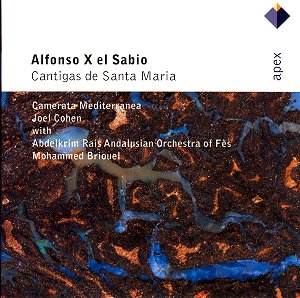
BUY NOW
AmazonUK AmazonUS Superbudget
Alfonso
X el SABIO (1221-1284)
Cantigas de Santa Maria
Nawba Ramal al-Maya Bughya (overture) – instrumental
[1:06]
Cantiga 100: Santa Maria, streta do dia
[3:24]
Cantiga 406: Ben vennas, Mayo [2:42]
Cantiga 370: Loemos muit’a Virgen [3:19]
Cantiga 90: Sola fusti, senlleira [3:44]
Cantiga 52: Mui gran derait’e – instrumental
[1:49]
Nawba Gharibat al-Husayn Tushiyas (prelude)
– instrumental [2:16]
Cantiga 230: Tod’ome deve dar loor [2:17]
Cantiga 130: Quen entender quiser [4:57]
Cantiga 56: Gran dereit’e [5:13]
Nawba Irak al-Ajam Mizan Dari – Sana "Kouli
Lmalihti" – instrumental [0:44]
Cantiga 320: Santa Maria leva [3:44]
Cantiga 200: Santa Maria loel [5:34]
Cantiga 417: Nobre don e muy precado
[5:14]
Nawba Gharibat al-Husayn, Mizan Bacit – Sana
"Kad nilto hibbi" – instrumental [1:46]
Cantiga 140: A Santa Maria dadas [3:35]
Nawba Rasd al-dhil Mizan Koddam – Sana "Allah
hoo Yalamo" [1:45]
Cantiga 250: Por nos Virgen Madre [2:39]
Camerata Meditarranea with Joel Cohen, Abdelkrim
Rais Andalusian Orchestra of Fes with Mohammed
Briouel
![]() APEX WARNER CLASSICS 2564619242 [56.10]
APEX WARNER CLASSICS 2564619242 [56.10]






